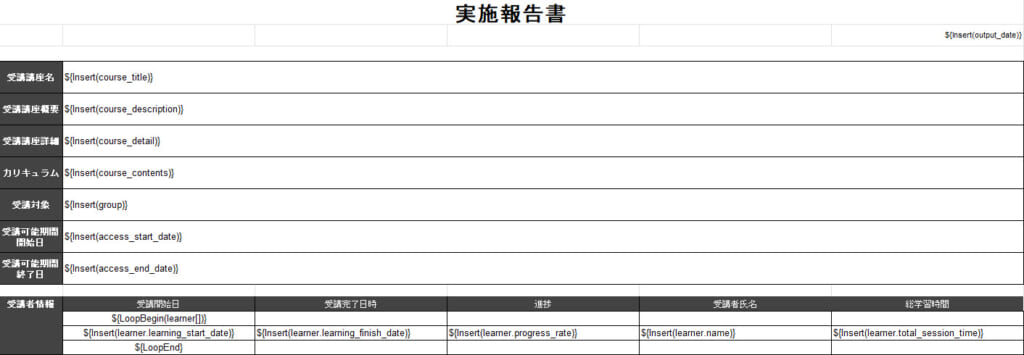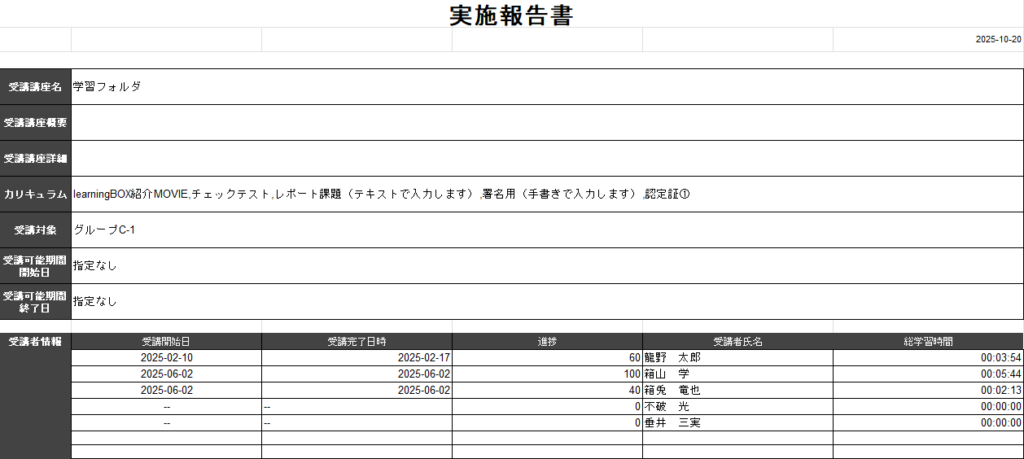Create statistics template
This section explains how to create templates for forms.
The template will be edited on the Excel file downloaded from learningBOX.
*For more details on the statistics settings and how to export the file, refer to Export statistics.
Here is an example of the "Course/Folder Learning History" template.
Macros are not allowed in the template Excel file.
Also, even if shapes are used in the template, they will not be reflected in the output forms.

Keys to insert
The following insert keys are available in the form templates.
▼ Information related to courses and folders
| Items | Keys to insert |
|---|---|
| Course | ${Insert(course_title)} |
| Overview | ${Insert(course_description)} |
| Details | ${Insert(course_detail)} |
| Curriculum | ${Insert(course_contents)} |
| Start date | ${Insert(access_start_date)} |
| End date | ${Insert(access_end_date)} |
▼Items regarding users
The following keys are used to loop, which is mentioned below.
| Items | Keys to insert |
|---|---|
| Name | ${Insert(learner.name)} |
| Department | ${Insert(learner.department)} |
| Position | ${Insert(learner.position)} |
| Study start date | ${Insert(learner.learning_start_date)} |
| Study Completion Date | ${Insert(learner.learning_finish_date)} |
| Learning rate | ${Insert(learner.progress_rate)} |
| Total time required | ${Insert(learner.total_session_time)} |
| Custom Fields | ${Insert(learner.%********%)} |
The "Custom Fields" can use any available field key created in the "Add Field" section of the "Input Fields" screen.
Enter the field key to the "********".
For more details on the input field, refer to Input field settings.
▼ Others
| Items | Keys to insert |
|---|---|
| Output Date | ${Insert(output_date)} |
| Selected group | ${Insert(group)} |
▼ Keys for looping
The data enclosed by the loop keys can be executed repeatedly and the information can be exported to the specified cell.
| Items | Keys to insert |
|---|---|
| Start loop | ${LoopBegin(learner[])} |
| End loop | ${LoopEnd} |
Loops
The following explain how to use a loop.
Example
Information about the user (name, department, etc.) must be enclosed in a loop start and end key.
The following is an example to use a loop. If a key is inserted into the template as shown below, names and departments will be exported per user.
■ Insert keys
・ Start of loop: ${LoopBegin(learner[])}
Name: ${Insert(learner.name)}
Department: ${Insert(learner.department)}
End of loop: ${LoopEnd}
■ Description in Templates
| Name | Department |
| ${LoopBegin(learner[])} | |
| ${Insert(learner.name)} | ${Insert(learner.department)} |
| ${LoopEnd} |
■Statistics exported
| Name | Department |
| Taro Tatsuno | sales section |
| Gaku Hakoyama | sales section |
| Ryuya Hakozagi | sales section |
| Hikaru Fuwa | personnel section |
| Sanmi Tarui | general affairs section |
*The keys ${LoopBegin(learner[])} and ${LoopEnd} are used to specify the repetitive process, and they will not be displayed as text on the statistics when exported.
When you use a loop
If you merge cells in the same row as ${LoopBegin(learner[])} and ${LoopEnd}, the loop processing will not work correctly and the output data may be corrupted.
▼Allowed: If there is a merged cell other than the row where the loop key is inserted

▼Disallowed: If cells are merged in a row where the loop key is inserted

Excel files that cannot be registered
Excel files that meet the following conditions cannot be registered.
Formulas and macros are included.
A nonexistent jumble key is being used.
Sheet to be registered
If multiple sheets exist in an Excel file, the left-most sheet will be registered.
If you download the sample template in the Statistics settings, the form will be exported as follows.

